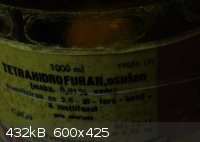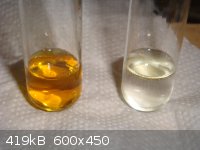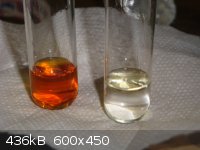yuno
Unregistered
Posts: N/A
Registered: N/A
Member Is Offline
|
|
Destroying THF peroxide with ascorbic acid
Hi,
I recently got a few liters of more than 30 years old THF. Test with KI solution verified that it is heavily contaminated with THF peroxide. I didn't
want to throw it away because I wanted to try to destroy the peroxide, so I searched the internet and found nothing simple.
Then I decided to try to stir in some ascorbic acid and got some interesting results. At first test with KI solution was positive and after an hour it
was negative. Ascorbic acid at first didn't seem to dissolve in THF but gradually did - in the same time peroxide tests started to be negative.
Droplets of something seem to separated from THF/ascorbic acid in KI test and solution also turned brown after about 10-15 minutes. I will put more
ascorbic acid in THF, let it stir overnight and then test it again.
What happened? Did ascorbic acid just prevented peroxide to oxidise iodide or it reacted with peroxide? When ascorbic acid is added to already brown
solution it quickly turns colourless.
  
[Edited on 11-5-2013 by yuno]
|
|
|
plante1999
International Hazard
    
Posts: 1936
Registered: 27-12-2010
Member Is Offline
Mood: Mad as a hatter
|
|
Did you simply mixed ascorbic acid for no reason? Ascorbic acid reduce peroxides, but I would have use something that don't form product that could be
soluble in THF. I guess sodium sulphite would do a nice job.
I never asked for this.
|
|
|
yuno
Unregistered
Posts: N/A
Registered: N/A
Member Is Offline
|
|
I found a paper in which they describe using natural antioxidants as peroxide formation inhibitors in various solvents. The only difference here is
that peroxide is already present. I currently don't have sodium sulphite or any similar salt so I can't try that. Why the product needs to be
insoluble in THF when you need to distill the THF anyway?
[Edited on 11-5-2013 by yuno]
|
|
|
gsd
National Hazard
   
Posts: 847
Registered: 18-8-2005
Member Is Offline
Mood: No Mood
|
|
There are several threads on this forum on this subject. UTFSE.
Search for the paper titled "distroying peroxides" which was posted in one of those threads and you will get several options to do the job.
Gsd
|
|
|
Adas
National Hazard
   
Posts: 711
Registered: 21-9-2011
Location: Slovakia
Member Is Offline
Mood: Sensitive to shock and friction
|
|
I think that some FeSO4 might do the job, but I am not sure.
Offtopic: Are you from Czech republic? :O
Rest In Pieces!
|
|
|
yuno
Unregistered
Posts: N/A
Registered: N/A
Member Is Offline
|
|
Quote: Originally posted by gsd  | There are several threads on this forum on this subject. UTFSE.
Search for the paper titled "distroying peroxides" which was posted in one of those threads and you will get several options to do the job.
Gsd |
Most information about destroying peroxides in organics solvents is for ethers which are immiscible with water. THF is miscible with water!
I'm not from Czech republic ! 
EDIT:
Today all ascorbic acid seems to dissolved in THF, test with KI is negative but something oily separated from solution
[Edited on 12-5-2013 by yuno]
|
|
|
Ephoton
Hazard to Others
  
Posts: 463
Registered: 21-7-2005
Member Is Offline
Mood: trying to figure out why I need a dark room retreat when I live in a forest of wattle.
|
|
thank you very interesting did not know you could use this otc compound to
reduce ether peroxides.
does it work for diethyl ?
disolves who cares just distill after all.
I always thought of hydroquinone for peroxides my self but this is easier
thanx again.
nice post.
on edit I wonder what it is doing in reaction.
making per ascorbic acid or splitting this acid.
no time to look into it these days but interesting none the less.
[Edited on 13-5-2013 by Ephoton]
e3500 console login: root
bash-2.05#
|
|
|
yuno
Unregistered
Posts: N/A
Registered: N/A
Member Is Offline
|
|
I don't know if it even works for the THF, that's why I want someone to confirm that peroxides are destroyed, or that ascorbic acid is just
interfering with KI test (reducing iodine to iodide, giving negative results). THF has different properties than ethers because it is miscible with
water and I don't want to risk distilling peroxidised THF and killing myself. It is 20-30 years old but some bottles were quite good protected from
light and the THF is dried (0.1% water) which also slows down peroxide formation. For this experiment I took the worst THF. I currently don't need it
but I plan to use it for Grignard reactions, it's easier to work with than diethyl ether.
Maybe this THF is too contaminated with peroxides for safe recovery. I have several other bottles with different amounts of peroxides, in every bottle
I added some diphenylamine just to prevent further peroxidation.
EDIT:
Some suggest destroying peroxides with solid KOH but others say that will set it off.
[Edited on 13-5-2013 by yuno]
|
|
|
Adas
National Hazard
   
Posts: 711
Registered: 21-9-2011
Location: Slovakia
Member Is Offline
Mood: Sensitive to shock and friction
|
|
Quote: Originally posted by yuno  |
EDIT:
Some suggest destroying peroxides with solid KOH but others say that will set it off.
[Edited on 13-5-2013 by yuno] |
How could that set it off when it is a very dilute solution of the peroxide? Don't be afraid. Also keep in mind that not every organic peroxide gets
decomposed by hydroxides.
Rest In Pieces!
|
|
|
smaerd
International Hazard
    
Posts: 1262
Registered: 23-1-2010
Member Is Offline
Mood: hmm...
|
|
This is a very old thread, but I wanted to say for the sake of archiving that Adas gave poor advice.
Telling someone not to be afraid of a solution which has tested positive for peroxides is kind of a non-pass. Telling someone to not be
cautious/afraid while adding potassium hydroxide to THF + peroxides is really dangerous. THF peroxides are known to have an often violent reaction
with KOH. The common advice is to attempt such an addition on a 1-5mL test-tube scale and note if there is a exothermic reaction. I haven't seen much
about KOH being used to remove peroxides but I have seen it mentioned as a potential pre-drying step before something more thurough.
The easiest and most common method to remove peroxides is essentially as follows (always check the literature verses word of mouth)...
For 150-400mL of THF with peroxides:
Load a chromatography column with 80-100g of basic activated alumina (chromatography grade).
Pass the solvent through the column without letting it run dry.
Quench the column carefully with cold 5% aqueous bisulfite solution, or I think it was iron chloride (look that step up). Dispose of the alumina
appropriately.
Test the solvent for peroxides. (repeat if necessary)
Note - this procedure removes stabilizers (BHT, etc), and the solvent must be stored under inert atmosphere and used in a few days. It also does a
great job of removing trace water from THF, so that's an added benefit.
|
|
|
sparkgap
International Hazard
    
Posts: 1234
Registered: 16-1-2005
Location: not where you think
Member Is Offline
Mood: chaotropic
|
|
Purification of Laboratory Chemicals says that "peroxides can also be removed by passage through a column of activated alumina, or by
treatment with aqueous ferrous sulfate and sodium bisulfate, followed by solid KOH. In both cases, the solvent is then dried and fractionally
distilled from sodium."
sparky (~_~)
"What's UTFSE? I keep hearing about it, but I can't be arsed to search for the answer..."
|
|
|
mackolol
Hazard to Others
  
Posts: 459
Registered: 26-10-2017
Member Is Offline
Mood: Funky
|
|
So do FeSO4 destroys preoxide? Because i want to oxidise THF with FeSO4 and H2O2 and I'm wonder if it won't form any deadly peroxides.
|
|
|
Texium
Administrator
       
Posts: 4580
Registered: 11-1-2014
Location: Salt Lake City
Member Is Offline
Mood: PhD candidate!
|
|
Adding THF to a Fenton-like system will likely form peroxides readily. That sounds like a very dangerous idea.
|
|
|
mackolol
Hazard to Others
  
Posts: 459
Registered: 26-10-2017
Member Is Offline
Mood: Funky
|
|
The yield is gammabutyrolactone in 60% yield. Doesnt the feso4 destroy peroxides? Or i will must check it by myself with KI and possibly treat it with
ascorbic acid?
|
|
|